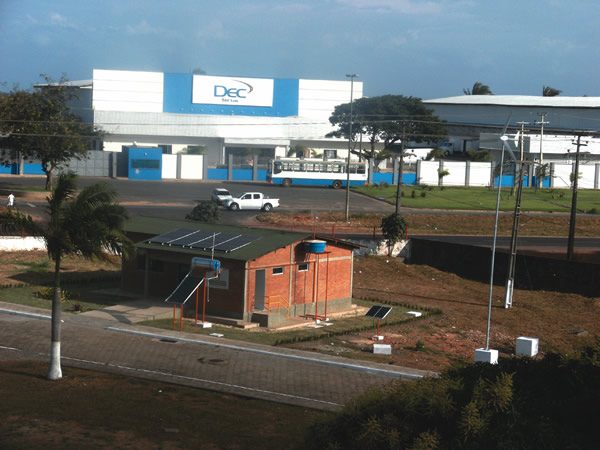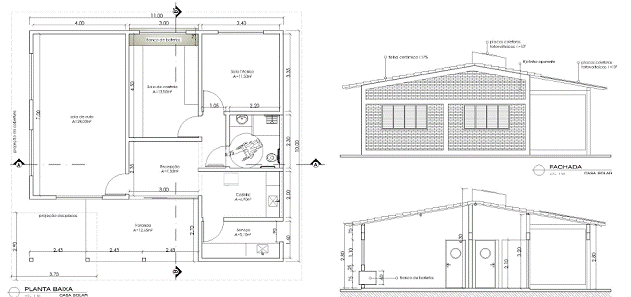Text adapted from Galdino et al. (2010).
SENAI-MA Demonstration Centre is located in a building designed and built specifically for this purpose, the Center for Technology Education and Mobile Actions - CETAM, industrial District of São Luís - MA (Figure 1). This building, with an area of about 100m2 is, as the example of the Solar House of CEPEL, similar to a conventional residential building, with classrooms, 2 bedrooms, bathroom, dining room/kitchen, laundry area and terrace.

Figure 1 - Photo of the Demonstration Centre in São Luis - MA
The room will serve for lectures and audio and visual projections, and one room will house switchboards and data acquisition system. The power is generated from an autonomous hybrid PV-wind system, though the dimensions have been provided for the PV system only. Despite the fact that the wind resource is not mapped by measurements, the site presents records that prove a favorable wind profile for its use. The use of this technology is of great importance for educational exemplification, since the coast of the state of Maranhão has favorable areas for the deployment of wind farms.
The anticipated loads are: lighting, refrigerator, 32" LCD TV, laptop computer, overhead projector, DVD and data acquisition system. The drinking water will be provided by an autonomous photovoltaic pumping system (not connected to the electrical system of the house) with its motor-powered surface pump in DC, simulacrum of a pumping system from a water body (e.g. river, dam). The hot water for consumption in the bathroom and kitchen is produced by a solar thermal system. The technical data of the Solar House of SENAI-MA is shown on Table 1.
Table 1 - Characteristics of systems of SENAI-MA Demonstration Centre | Hybrid system | Sun radiation | 4.00 kWh/m2.day |
|---|
| Daily consumption | 3.5 kWh/day |
| System voltage | 48 Vdc |
| Photovoltaic array | 1560 Wp (4s * 3p * 130 Wp) |
| Battery Bank | 32.64 kWh (4s * 4p * 170 Ah @C20) |
| Wind Turbine | 1 kW |
| Solar water heating | Thermal reservoir | 200 L |
|---|
| Thermal Collector | 1 m2 |
| Water pumping | Daily consumption | 600 L/day |
|---|
| Photovoltaic array | 54 Wp |
| Motor pump | 12 Vdc, surface, diaphragm-type |
The amount of solar radiation that was adopted in Table 1 refers to the lowest average monthly rate in São Luis - MA, according to Atlas Solarimétrico do Brasil (UFPE,2000).
The roof of the building was designed with the inclination and orientation characteristics that are appropriate to receive a thermal solar system running on thermosiphon, as well as the photovoltaic energy conversion and pumping systems. The SENAI-MA center also uses a water pumping mobile kit and another power conversion kit. A view of this construction is presented on Figure 2.

Figure 2 - Views of the architectural design of the building of the Demonstration Center in São Luís (MA).
1.1. Data Acquisition System
The system is fully monitored and controlled through a data acquisition system developed and implemented by SENAI based on a PLC, a notebook computer and wireless network. The PLC used is equipped with 24 digital inputs, 14 analog inputs and 24 digital outputs, the use of which is described below.
The analog monitored quantities are as follows:
- Voltage (Vdc) and Current (Icc) of the Photovoltaic Panel;
- Solar radiation incident on the plane area of the photovoltaic panel (W/m2);
- Voltage (Vdc) and Current (Acc) in the battery bank;
- Voltage (Vac) and current (Aac) in two sets of loads A and B;
- Temperature of the PV panel and ambient temperature (°C);
The digital inputs are distributed as follows:
- 10 switches for remote control of lighting;
- 6 occupancy sensors in various environments;
- Remote on/off system;
- Automatic/manual lighting control;
- Emergency button;
The acquisition system consists of a control box allowing you to view the state of all electrical loads as well as the remote activation of electrical loads. The analog values are transmitted via wireless network to a computer in the building of SENAI-MA, where they are stored every second. A notebook computer inside the house will allow visitors to access the data.
1.2. Bibliography
Galdino, M.A. et al, 2010, "Criação de Quatro Centros de Demonstração de Energias Renováveis em diferentes regiões do país". In: Congresso brasileiro de Energia Solar, 3., Belém, Set.
UFPE, 2000. Atlas Solarimétrico do Brasil: Banco de Dados Terrestres. 1ª ed. Recife, Ed. Universitária da UFPE. ISBN 85-7315-142-0.